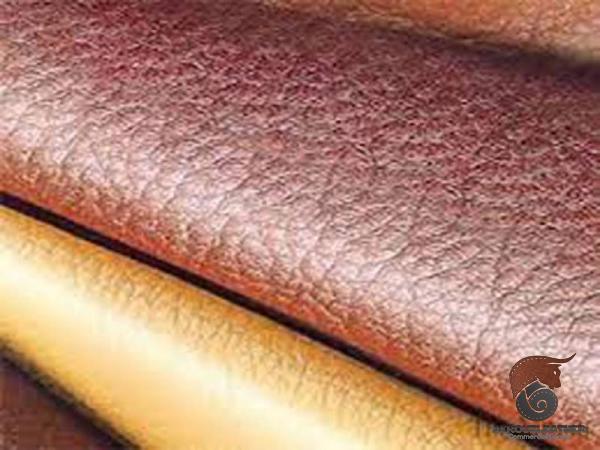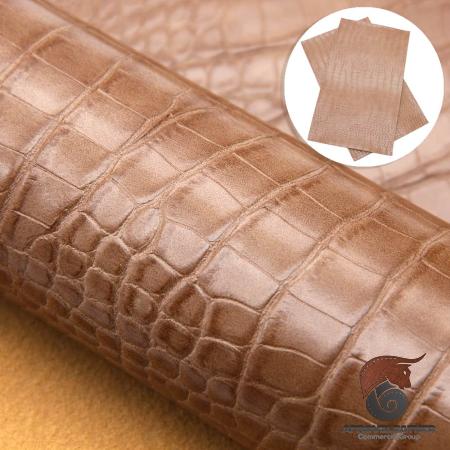The luxury goods industry is known for using exotic animal skins to produce high-end products, such as handbags, shoes, and accessories. Ostrich leather and crocodile leather are two of the most sought-after materials in this industry due to their unique textures, durability, and rarity. This article aims to provide a comprehensive comparison between ostrich leather and crocodile leather, focusing on their sources, characteristics, and applications in luxury fashion. 1. Origins and Sources: 1.1 Ostrich Leather: Ostrich leather is derived from the skin of ostriches, which are native to Africa. Ostrich farming is now a regulated industry aiming to protect the species and sustainably harvest their leather. South Africa is the largest producer of ostrich leather, accounting for approximately 85% of the world’s supply. The leather is obtained through a meticulous tanning process that enhances its durability and unique texture. 1.2 Crocodile Leather: Crocodile leather is sourced from various species, including Nile crocodile, Australian saltwater crocodile, and American alligator. These reptiles are found in different regions across the world, such as Africa, Australia, and the United States. The leather industry obtains crocodile skins mainly from farm-raised specimens to prevent endangerment of wild populations. Africa, particularly Zimbabwe and Zambia, is recognized as a significant exporter of crocodile leather. 2. Characteristics and Appearance: 2.1 Ostrich Leather: Ostrich leather is known for its distinctive quill pattern, which is a result of the structural arrangement of the fibers on the bird’s skin.
leather
 The natural skin is characterized by large follicles with small parallel quill marks, creating a visually appealing texture. Ostrich leather is supple, flexible, and highly resistant to wear and tear. It is renowned for its breathability, moisture resistance, and soft touch, making it a preferred luxury material among designers. 2.2 Crocodile Leather: Crocodile leather is recognized for its scale pattern, which varies depending on the crocodile species. Nile crocodile leather features rectangular-shaped tiles, while Australian saltwater crocodile leather exhibits more natural, irregular scales. American alligator leather boasts distinctive square-shaped scales. These unique patterns and textures contribute to the allure and value of crocodile leather products. The durability, strength, and water resistance of crocodile leather make it a desirable option in luxury fashion. 3. Manufacturing Process: 3.1 Ostrich Leather: The production of ostrich leather involves several meticulous steps. After obtaining the ostrich skins, the tanners perform various processes, including buffering, tannin application, and dyeing. The leather is then stretched and left to dry naturally. These processes enhance the leather’s strength, flexibility, and color permanence. The resulting ostrich leather is then ready for use in luxury product manufacturing. 3.2 Crocodile Leather: The manufacturing process of crocodile leather involves various stages to ensure premium quality. The first step involves salt curing the raw skins to preserve them. The skins are then cleaned and submerged in a tannin bath to achieve better texture and strength. Next, the skins are treated with dyes or pigments to enhance color and finish. The final stage involves drying, pressing, and buffing to achieve the desired texture and shine. These processes transform the raw crocodile skins into luxurious leather for use in high-end fashion items.
The natural skin is characterized by large follicles with small parallel quill marks, creating a visually appealing texture. Ostrich leather is supple, flexible, and highly resistant to wear and tear. It is renowned for its breathability, moisture resistance, and soft touch, making it a preferred luxury material among designers. 2.2 Crocodile Leather: Crocodile leather is recognized for its scale pattern, which varies depending on the crocodile species. Nile crocodile leather features rectangular-shaped tiles, while Australian saltwater crocodile leather exhibits more natural, irregular scales. American alligator leather boasts distinctive square-shaped scales. These unique patterns and textures contribute to the allure and value of crocodile leather products. The durability, strength, and water resistance of crocodile leather make it a desirable option in luxury fashion. 3. Manufacturing Process: 3.1 Ostrich Leather: The production of ostrich leather involves several meticulous steps. After obtaining the ostrich skins, the tanners perform various processes, including buffering, tannin application, and dyeing. The leather is then stretched and left to dry naturally. These processes enhance the leather’s strength, flexibility, and color permanence. The resulting ostrich leather is then ready for use in luxury product manufacturing. 3.2 Crocodile Leather: The manufacturing process of crocodile leather involves various stages to ensure premium quality. The first step involves salt curing the raw skins to preserve them. The skins are then cleaned and submerged in a tannin bath to achieve better texture and strength. Next, the skins are treated with dyes or pigments to enhance color and finish. The final stage involves drying, pressing, and buffing to achieve the desired texture and shine. These processes transform the raw crocodile skins into luxurious leather for use in high-end fashion items.
Specifications of leather
 4. Durability and Strength: 4.1 Ostrich Leather: Ostrich leather is highly durable and resistant to cracking, making it a robust material for luxury products. Its natural fat called “lanolin” allows it to resist moisture, resulting in higher longevity compared to other leathers. Ostrich leather’s unique fiber structure contributes to its resilience and makes it less prone to tearing or creasing. It ages gracefully, forming attractive patinas over time. 4.2 Crocodile Leather: Crocodile leather is renowned for its exceptional strength and durability. Its tightly interwoven fibers provide a solid structure that resists wear and tear, making it long-lasting. The high level of collagen in crocodile leather enhances its tensile strength and resistance to stress. Additionally, crocodile leather has excellent water resistance due to the presence of natural oils, ensuring its longevity when exposed to moisture. 5. Availability and Rarity: 5.1 Ostrich Leather: Ostrich leather is considered relatively rare due to the limited population of ostriches worldwide. The farming processes involved in ostrich leather production require extensive care and expertise, resulting in a limited supply of this luxury material. The scarcity of ostrich leather contributes to its exclusivity and higher price in the luxury fashion market. 5.2 Crocodile Leather: While crocodile leather is not as rare as ostrich leather, its availability is still limited due to legal and ethical regulations. The farming of crocodiles for their skins requires strict monitoring and adherence to animal welfare guidelines. Consequently, the supply of top-quality crocodile leather remains restricted, maintaining its high value in the luxury industry.
4. Durability and Strength: 4.1 Ostrich Leather: Ostrich leather is highly durable and resistant to cracking, making it a robust material for luxury products. Its natural fat called “lanolin” allows it to resist moisture, resulting in higher longevity compared to other leathers. Ostrich leather’s unique fiber structure contributes to its resilience and makes it less prone to tearing or creasing. It ages gracefully, forming attractive patinas over time. 4.2 Crocodile Leather: Crocodile leather is renowned for its exceptional strength and durability. Its tightly interwoven fibers provide a solid structure that resists wear and tear, making it long-lasting. The high level of collagen in crocodile leather enhances its tensile strength and resistance to stress. Additionally, crocodile leather has excellent water resistance due to the presence of natural oils, ensuring its longevity when exposed to moisture. 5. Availability and Rarity: 5.1 Ostrich Leather: Ostrich leather is considered relatively rare due to the limited population of ostriches worldwide. The farming processes involved in ostrich leather production require extensive care and expertise, resulting in a limited supply of this luxury material. The scarcity of ostrich leather contributes to its exclusivity and higher price in the luxury fashion market. 5.2 Crocodile Leather: While crocodile leather is not as rare as ostrich leather, its availability is still limited due to legal and ethical regulations. The farming of crocodiles for their skins requires strict monitoring and adherence to animal welfare guidelines. Consequently, the supply of top-quality crocodile leather remains restricted, maintaining its high value in the luxury industry.
buy leather
 6. Applications in Luxury Fashion: 6.1 Ostrich Leather: Ostrich leather is predominantly used in the production of high-end accessories, such as handbags, wallets, belts, and shoes. The unique texture and distinct quill pattern of ostrich leather add a luxurious touch to these products, making them highly coveted by fashion enthusiasts. Its durability and versatility make ostrich leather a popular choice for both men’s and women’s fashion. 6.2 Crocodile Leather: Crocodile leather is admired and used extensively in the luxury fashion industry. Handbags, wallets, boots, and watch straps are among the most common products made from crocodile leather. The exotic and high-end appeal of crocodile leather products attracts discerning customers seeking unique, luxurious offerings. The durable and elegant nature of crocodile leather makes it a prized material for designers. Conclusion: In conclusion, both ostrich leather and crocodile leather are highly sought-after materials in the luxury fashion industry. Each material possesses unique characteristics, such as the quill pattern of ostrich leather and the scale pattern of crocodile leather, making them visually distinctive. Both materials offer exceptional durability, strength, and water resistance, making them ideal for luxury fashion products. While ostrich leather is relatively rarer, crocodile leather remains a premium material known for its elegance and resilience. Ultimately, personal preference, accessibility, and exclusivity determine the choice between ostrich leather and crocodile leather in the world of luxury fashion.
6. Applications in Luxury Fashion: 6.1 Ostrich Leather: Ostrich leather is predominantly used in the production of high-end accessories, such as handbags, wallets, belts, and shoes. The unique texture and distinct quill pattern of ostrich leather add a luxurious touch to these products, making them highly coveted by fashion enthusiasts. Its durability and versatility make ostrich leather a popular choice for both men’s and women’s fashion. 6.2 Crocodile Leather: Crocodile leather is admired and used extensively in the luxury fashion industry. Handbags, wallets, boots, and watch straps are among the most common products made from crocodile leather. The exotic and high-end appeal of crocodile leather products attracts discerning customers seeking unique, luxurious offerings. The durable and elegant nature of crocodile leather makes it a prized material for designers. Conclusion: In conclusion, both ostrich leather and crocodile leather are highly sought-after materials in the luxury fashion industry. Each material possesses unique characteristics, such as the quill pattern of ostrich leather and the scale pattern of crocodile leather, making them visually distinctive. Both materials offer exceptional durability, strength, and water resistance, making them ideal for luxury fashion products. While ostrich leather is relatively rarer, crocodile leather remains a premium material known for its elegance and resilience. Ultimately, personal preference, accessibility, and exclusivity determine the choice between ostrich leather and crocodile leather in the world of luxury fashion.

Your comment submitted.